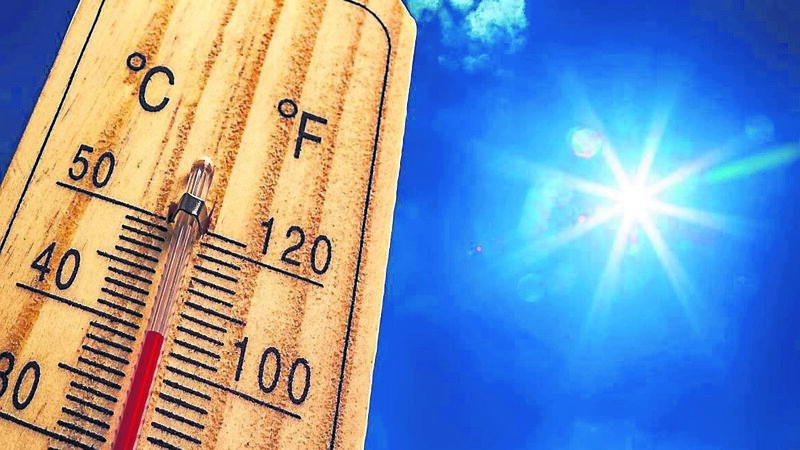Crunching numbers on Irish climate change

Last year was shown to be Ireland’s warmest year on record, records previously held by 1945 and 2007.
THE highest temperature currently recognised that was ever recorded in Ireland was taken at Kilkenny Castle in 1887, and in the shade on that day the thermometer read 33.3C.
This record has stood for 136 years and it means Ireland is the only country in Europe to have a national heat record that was set in the 19th century.
‘Currently recognised’ is a key term here, as Katherine Dooley, of the Environmental Protection Agency, pointed out in January, where she noted that there are, actually, higher recordings that date further back: for instance, July, 1876, in Phoenix Park, Dublin, where 33.5C was recorded.
So why isn’t that older recording recognised officially amongst Ireland’s hottest days?
The lack of consistent standardisation for these old records makes it very difficult to incorporate these data into modern, stringently standardised data sets.
Standardisation creates an equal playing field for data recording and analysis to take place. Without it, data cannot be fairly compared. Standardisation when recording temperature, or any physical phenomena, crucially requires uniformity across instrumentation and methodologies.
The 136-year-old Kilkenny record was systematically analysed and suggested to be at least dubious and unreliable, in a 2023 report, due to its poor standardisation traceability.
If the Kilkenny record was no longer recognised, then the new record holder would be Boora in Offaly, in June, 1976, where a recording of 32.5C was taken. The records show this to be the hottest 20th century day in Ireland.
Met Éireann, on July 18, 2022, recorded 33C at Phoenix Park, which made it Ireland’s hottest 21st century day, but potentially, if the Kilkenny Castle record was to be ignored, Ireland’s hottest day on record.
With this in mind, it’s not impossible for there to have been extremely hot days in the 19th century - it’s actually very likely and interesting to consider - but given the associated unreliability, it’s difficult to view the 1887 Kilkenny Castle recording with absolute accuracy.
So, the question remains, where are we today?
Normals
To discern where we are today, it is imperative to produce a baseline to compare against. Without that, one cannot observe deviations from it.
A baseline is established using 30-year averages, deemed appropriate by the World Meteorological Organisation (WMO). The 30-year block is somewhat arbitrary, but it is considered sufficient to capture a trend in the weather, which is essentially the definition for climate.
These 30-year averages are called ‘normals’. The reason periods of at least 30 years are required is because they separate climate variability from climate trends. Climates, by their very nature, are complex systems in constant motion and variability is inevitable. But what these long-term data sets provide are trend lines and opportunities to compare 30-year blocks against one another.
For example, 1961-1990 is a climate normal.
1991-2020 is also a climate normal. When these normals are compared against each other, we see an annual average air temperature increase of 0.7C in the 1991-2020 normal.
Anomalies
Average annual air temperature is established using a 30-year normal data set. This average temperature is represented as a horizontal line across a graph. Each individual, annual value is then placed onto the graph and they either show an increase or a decrease from the norm - these are known as anomalies.
A Met Éireann graphic illustrates how the 20th century appeared to have oscillating normals of cool (1900-1930), warm (1931-1960), cool (1961-1990), and a warm normal that moved into the 21st century (1991-2020).
According to Met Éireann, the ‘fixed reference period’ used by the WMO is 1961-1990. This normal average is then compared against the entire 20th century and beyond.
The increase in anomalous temperature recordings is stark from the beginning of the 21st century, but bear in mind that it’s being compared to a cool, mid-century period. Perhaps it wouldn’t look so stark if it were compared to 1931-1960. Nonetheless, the temperature trend is rising rather than declining, with daily temperature recordings being broken more regularly.
Recent Temperatures
The annual European temperature for 2020 was the hottest on record, with 2022 being the second hottest. Record-breaking years are now more densely packed together, with Europe’s ten warmest years occurring in the 21st century, and Europe’s five warmest years occurring since 2014.
Last year was shown to be Ireland’s warmest year on record, records previously held by 1945 and 2007.
It has been provisionally suggested that June of 2023 will be Ireland’s warmest June ever recorded, but it’s too early to declare on the annual average.
Temperatures are rising consistently in Ireland and around the globe for a multivariate of reasons, with long-term implications that are still unclear. Wading through the deluging information landscape on this topic can be difficult, and hence, it is my aim to provide simplified and helpful explanations on this topic.







 App?
App?




